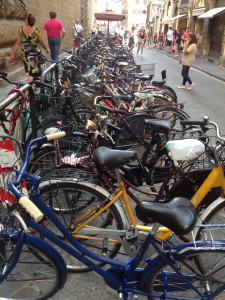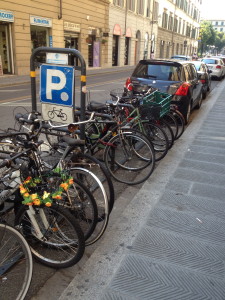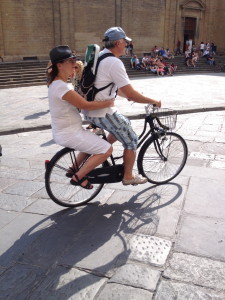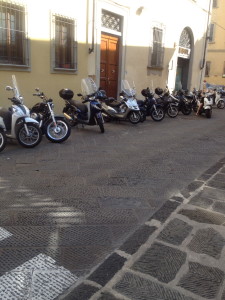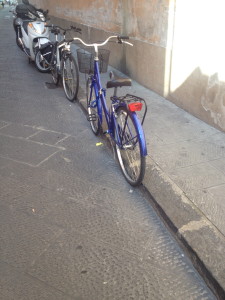The junker bikes of Florence
|
This summer I’ve noticed that the city bikes used in Florence are generally old and decrepit. I understand that these bikes are intentionally unattractive to thieves, and in Italy it seems that bikes are exclusively used for either performance or practical cycling, but I’m surprised that a fleet of bikes so universally crummy can even be used to get around. This observation isn’t based on a small sample or an exaggeration. On most bike racks in Florence with about 20 bikes, you’ll find about 10 that are abandoned or have flat tires. You’ll find five that look to be out of service but have pumped-up tires, indicating some use. The best five will appear to be in working condition, though they’re likely to be very old. The best bike in the rack will be worse than the worst bike you’d find in San Francisco or London. How do riders manage to keep these bikes going? What shops cater to this trade? Most bike shops are the typical performance-bike variety. I’ve seen a few small garages that serve city beater bikes, but where are these things traded? What do riders do when a tire goes flat and the axle nuts are rusted and the headset is loose and the fender stays are broken and the crankcase is bent? (Answer: they just keep riding it). It occurred to me that maybe more valuable city bikes are being stored indoors at offices and workplaces, so I started looking at bikes in motion. Alas, on average they’re no nicer than those one sees parked – and the number of bike commuters is pretty low. These beleaguered city bikes announce their presence on Florence’s flagstone streets, rattling and clanking along at a pace not much faster than a walk. Most Italian cities follow this pattern, though Milan has a stylish fixed-gear culture. No one seems to be commuting very far on bikes – motor scooters have captured that market. Outside the touristy city-center of Florence, the biggest streets often have protected bike lanes, but the lanes are narrow, in poor repair, and have dangerous entry and exits, so they are rarely used. Cars and scooters aren’t particularly old and in disrepair. Here’s a typical lineup of scooters and motorcycles Is the difference between the average motor scooter’s condition and the average bikes solely due to the ease of stealing bikes? Don’t get me wrong – I have nothing against a practical city bike and I love the idea of keeping old equipment on the road instead of buying new stuff all the time. But this isn’t some sort of city-bike Utopia like Amsterdam or Copenhagen – it’s more like the automobile fleet in Havana – sad, sorry machines that discourage the idea of ever using them. The only folk who must be more discouraged and beaten-down than Florentine bike commuters are the bike thieves. There’s nothing of value to steal. Most bikes are locked with only a flimsy chain. U-locks are rare. In fact, if all the bike locks disappeared overnight, the city could just convert all the rolling stock to an ad hoc bike share system, each bike equally clunky, ill-fitting, and awkward. An interesting consequence of this low-value, low-security fleet of bikes is that riders will often park their bikes in traffic, resting a pedal on the curb between the road and the sidewalk. These bikes stick out into auto and bus traffic rather than take up space on the crowded sidewalks. I sometimes imagine that their owners secretly hope that they’ll return to find their bikes hopelessly smashed and tangled beneath the wheels of a passing bus, a Viking burial for a rusted clunker.
|
